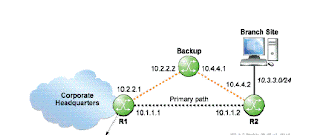Floating Static route:-
A floating static route provides a means for traffic to follow a backup
static route, in the event the router detects a failure along the path
used by the primary static route.config>router>
static-route 10.3.3.0/24 next-hop 10.1.1.2config>router> In the example above, router R1 has two static routes configured. The top static route points all traffic destined to
the branch site’s Ethernet segment out of the primary path. Because there is no preference setting explicitly stated
on this line of the configuration, the default preference value of 5 is used. On the next line, router R1 has configured
a second static route to the branch site’s Ethernet segment. In this case, the preference value is set to 200.
The static route with the lowest preference value is the preferred route. As a result, all traffic will use the primary
path as long as it is operational. In the event of a failure on the primary path, the static route that points out the
interface will be removed and the static route across the backup link will be added to the routing table and become
operational. This backup path, when configured with static routes, is commonly called a floating static route.A router’s primary purpose is to forward data from one location to another. To forward data to a network, a router
needs to know the location of that network in the topology. There are two ways a router can learn the location of a
network. First, a router can communicate with other routers via a dynamic routing protocol. Second, an
administrator can program in a static route. Static routes are manually configured entries in the router that define a
network and the path to take to access the network. Alcatel-Lucent routers support static routes. The command
structure to program a static route is simple and easily understood.
In the example above, routers R1 and R2 have routing tables. Both routers automatically know about the networks
that they are directly connected to. This is accomplished by configuring the IP address and mask on the interfaces. In
addition, both routers have been configured with static routes to the remote Ethernet segments. The routing table
reflects this configuration with route entries.There are 3 places where a static route can be pointed.
next-hop — Specifies the directly connected next-hop IP address used to reach the destination. If the next-hop is
over an unnumbered interface, the ip-int-name of the unnumbered interface (on this node) can be configured.
The ip-addr configured here can be either on the network or the access side of this node. The address must be
associated with a network that is directly connected to a network configured on this node.
The configured ip-addr is not directly connected to a network configured on this node. The static route remains
valid as long as the address configured as the indirect address remains a valid entry in the routing table. Indirect
static routes cannot use an ip-prefix/mask to another indirect static route. The ip-addr configured can be either
on the network or the access side, and is normally at least one hop away from this node.
indirect — Specifies that the route is indirect as well as the next-hop IP address used to reach the destination.
static route, it will be silently discarded.Black hole — Specifies that the route is a black hole route. If the destination address on a packet matches this Given below is an exampls of a default static route all the traffic is forwarded to the
Given below is an exampls of a default static route:-
Indirect Static route:-
In this case the indirect route can only be resolved by a dynamic routing protocol.
Static routes with a CPE Check:-
CPE-Check
This parameter specifies the IP address of the target CPE device. ICMP pings will be sent to this target IP address. CPCheck
must be configured to enable the CPE connectivity feature for the associated static route. The target-ipaddress
cannot be in the same subnet as the static route subnet itself, so as to avoid possible circular referencesA static route configured with CPE-check verifies connectivity by
sending an ICMP Ping to the target IP every 2 seconds. The static
route is considered down after 3 missed ICMP replies.In the above example if there are 3 icmp ping misses the static routes is deactivated.

One concept for traffic filtering is filters, also known as access control lists (ACL). ACLs enable you to filter packets
based on the information contained in their headers. Because the router must examine packet headers to make a
filtering decision, packet filtering adds some overhead to the processing of the packets. This overhead has an impact
on performance.
A complementary solution to both routing and filtering is to use black hole routes. If the destination address on a
packet matches the black hole route, that packet will be silently discarded.





Business Promotion: Blog and article sites provide businesses with a platform to promote their products and services. By sharing informative and engaging content, Archiving emails save space gmail companies can build brand awareness, establish thought leadership, and attract potential customers.
ReplyDelete